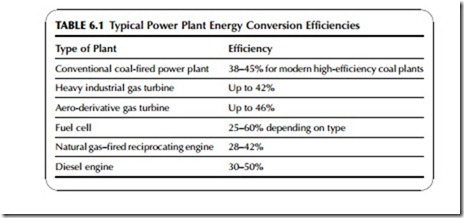CHP TECHNOLOGY
All types of power generation technology that are based on heat engines are capable of being integrated into a combined heat and power system. Thus, all fossil fuel–fired power plants and biomass power plants can be adapted to create CHP systems. In addition, electrochemical fuel cells can be an excellent source of heat and power. Among renewable technologies, solar thermal power plants can provide heat in addition to electricity if necessary, and geothermal energy has been widely exploited for both electricity generation and district heating. Other renewable technologies like wind, hydropower, and marine power involve no heat generation. However, solar photovoltaic power genera- tion can, in principle at least, be exploited in conjunction with solar heating because the solar cell only uses a part of the incident light and rejects most of the heat-bearing infrared radiation. Nuclear power, too, can be exploited for heat and power generation although its use is rare.
While this range of technologies offers a wide choice for a CHP plant, the type of heat required from a CHP application will often narrow the choice of technology. If high-quality steam is demanded then a source of high-temperature waste heat will be needed. This can be taken from a steam turbine–based power plant, it can be generated using the exhaust of a gas turbine, and it can be found in a high-temperature fuel cell. Other generating systems such as piston engines or low-temperature fuel cells are only capable of generating hot water, and perhaps low-quality steam.
The way in which a CHP plant is to operate is another important consideration. Which of the two types of energy—heat or electricity—will take priority? If heat is the most important consideration, particularly if this is high-grade industrial heat, then a system based on a steam-generating boiler and steam tur- bine will probably be most appropriate. The boiler will be sized to meet the maximum steam demand while a steam turbine is available to exploit excess steam to generate electricity. If there is sizable demand for both heat and electricity, then either a steam turbine of a gas turbine–based system might be the most suitable, with exhaust heat from the gas turbine used to generate steam and a steam turbine to exploit any excess. However, this will require an electricity demand at least equal to the output of the gas turbine generator.
For smaller applications and where only hot water is needed, a reciprocating engine, micro-turbine, or low-temperature fuel cell might offer the best match. Again, however, the mode of operation will determine the optimum choice. If the unit is to supply power to a particular consumer or group of consumers, with its output following their demand, then a generating unit that can operate effi- ciently at different load levels such as a piston engine or fuel cell will probably be the best solution. However, if it is going to provide base-load generation then part-load efficiency will be of less significance.
Finally, location will be important. It will not be possible to install some types of CHP plant in urban areas because of the emissions and the noise they generate. Therefore, this will limit the technologies available for use in this situation.
The quantity of heat that will be available will vary from technology to tech- nology. Table 6.1 gives typical energy conversion efficiency ranges for modern fossil fuel–burning power plants. However, not all the energy that is not con- verted into electricity will be available as heat. Modern high-efficiency coal- fired power plants can operate between 38% and 45% efficiency, though there are many that are much less efficient. However, high-efficiency coal-fired plants produce little usable waste heat unless overall efficiency is compromised, because the steam exiting the steam turbine is generally at a very low temperature and pressure. Gas turbines provide more flexibility while offering a similar electrical energy conversion efficiency because their exhaust gases can provide high-grade heat.
Where even more flexibility is required, it is possible to design a plant to produce less electricity and more heat than the efficiency figures in Table 6.1 suggest. Some technologies are amenable to this strategy, others are not. Most flexible are boiler/steam turbine plants, but gas turbine CHP units can easily be adapted in this way too.
All the technologies employed in CHP plants have their own chapters in this book where detailed accounts of their operation can be found. In discussing these technologies here, consideration will only be given to factors of specific relevance to CHP. Please refer to the other chapters for fuller accounts of each technology.
